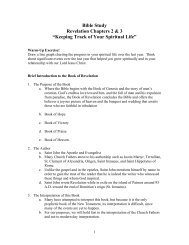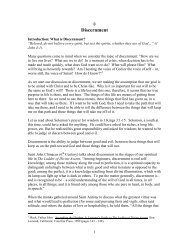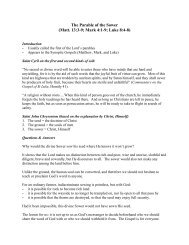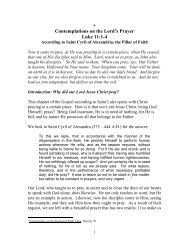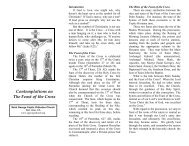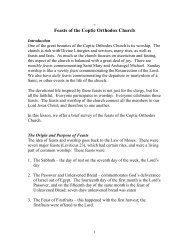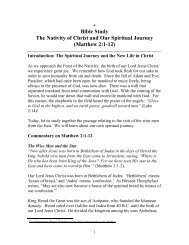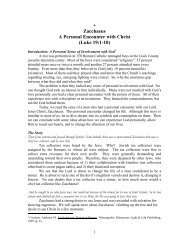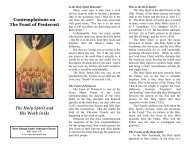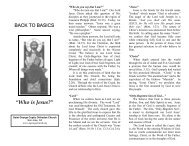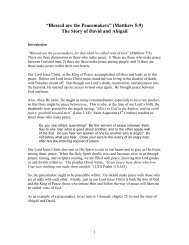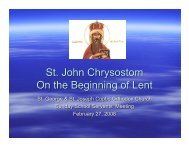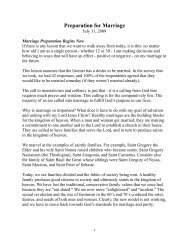The Raising of Incense - Saint George & Saint Joseph Coptic ...
The Raising of Incense - Saint George & Saint Joseph Coptic ...
The Raising of Incense - Saint George & Saint Joseph Coptic ...
Create successful ePaper yourself
Turn your PDF publications into a flip-book with our unique Google optimized e-Paper software.
HEAVEN ON EARTH<br />
<strong>The</strong> <strong>Raising</strong> <strong>of</strong> <strong>Incense</strong><br />
<strong>Saint</strong> <strong>George</strong> <strong>Coptic</strong> Orthodox Church<br />
San Jose, CA<br />
www.stgeorgechurch.org<br />
Get Ready!<br />
A town received the news that their king<br />
was coming for a visit. On the morning <strong>of</strong><br />
his visit, while the citizens were still making<br />
last minute preparations, a young boy went<br />
to the edge <strong>of</strong> town to await the arrival <strong>of</strong><br />
the visitor he had only heard about. <strong>The</strong><br />
king arrived quietly at dawn and found him<br />
waiting alone. After having spent a few<br />
hours talking with each other, the boy joined<br />
the king and entered town together. Now<br />
the young boy no longer felt that he was<br />
welcoming a stranger, but an old friend.<br />
One factor that prevents us from fully<br />
benefiting from the Divine Liturgy is<br />
coming late. <strong>The</strong> <strong>Raising</strong> <strong>of</strong> <strong>Incense</strong>, which<br />
takes place before the start <strong>of</strong> the Divine<br />
Liturgy, prepares us for the arrival <strong>of</strong> the<br />
King. This service prepares us for the two<br />
key parts <strong>of</strong> the Divine Liturgy by which we<br />
receive the Lord most personally: 1) the<br />
Reading <strong>of</strong> the Holy Gospel and 2) the<br />
Eucharist. In attending the <strong>Raising</strong> <strong>of</strong><br />
<strong>Incense</strong>, we will strengthen our relationship<br />
with the Lord through its prayers, and know<br />
more intimately who it is we are receiving.<br />
What is the <strong>Raising</strong> <strong>of</strong> <strong>Incense</strong><br />
<strong>The</strong> service <strong>of</strong> the <strong>Raising</strong> <strong>of</strong> <strong>Incense</strong><br />
takes place on the evening before and on the<br />
morning <strong>of</strong> the Divine Liturgy. <strong>The</strong> evening<br />
service is also known as Vespers, while the<br />
morning service is known as Matins. 1<br />
<strong>Incense</strong> is produced by burning gums or<br />
resins on charcoal. 2 <strong>The</strong>se substances are<br />
<strong>of</strong>ten mixed with perfumed oils, so that they<br />
produce a sweet-smelling aroma when<br />
burned. <strong>The</strong> priest raises and <strong>of</strong>fers incense<br />
around the church by means <strong>of</strong> the censer.<br />
<strong>The</strong> <strong>Raising</strong> <strong>of</strong> <strong>Incense</strong> contains the<br />
following prayers and hymns in this order:<br />
1. Introduction and the Lord’s Prayer<br />
2. <strong>The</strong> Prayer <strong>of</strong> Thanksgiving<br />
3. <strong>The</strong> Verses <strong>of</strong> Cymbals and the first<br />
Procession <strong>of</strong> <strong>Incense</strong><br />
4. <strong>The</strong> Litanies (for the departed, the sick, the<br />
travelers, the oblations).<br />
5. Prayers (“Graciously, O Lord”, the Gloria,<br />
the Thrice-Holy Prayer, the Lord’s Prayer)<br />
and the second Procession <strong>of</strong> <strong>Incense</strong><br />
6. <strong>The</strong> Doxologies<br />
7. <strong>The</strong> Introduction to the Creed and the Creed<br />
8. <strong>The</strong> Prayer <strong>of</strong> “O God, have mercy upon us”<br />
9. <strong>The</strong> Litany for the Gospel and the Gospel<br />
Reading<br />
10. <strong>The</strong> Five Short Litanies (for peace, the<br />
fathers, the place, the waters/plants/fruits,<br />
and the assemblies).<br />
11. <strong>The</strong> Absolutions, Conclusion, and Blessing.<br />
<strong>The</strong> Litany for the Departed is only<br />
prayed during Vespers and Saturday’s<br />
Matins service. <strong>The</strong> prayer <strong>of</strong> “Graciously,<br />
O Lord” is only said in the evening.<br />
During the Matins service on Sunday<br />
and major feast days, the Litany for the Sick<br />
and the Litany for the Oblations is prayed.<br />
On days other than Saturdays, Sunday, and<br />
major feast days, the Litany for the<br />
Travelers is prayed instead <strong>of</strong> the Litany for<br />
the Oblations. <strong>The</strong> Gloria is prayed during<br />
Matins only.<br />
<strong>Incense</strong> in the Holy Scriptures<br />
<strong>The</strong> <strong>Coptic</strong> Orthodox Church bases her<br />
rites on the Holy Scriptures. In the early<br />
years <strong>of</strong> Christianity, the <strong>of</strong>fering <strong>of</strong> incense<br />
was <strong>of</strong>ten associated with pagan worship,<br />
and many Christians were persecuted<br />
because they refused to raise incense before<br />
idols. With the passing <strong>of</strong> idolatrous<br />
persecution, the biblical tradition <strong>of</strong> the use<br />
<strong>of</strong> incense returned to Church worship.
In the Old Testament, the Jews were<br />
only allowed to <strong>of</strong>fer incense in the Temple.<br />
<strong>The</strong> use <strong>of</strong> incense in the New Testament,<br />
therefore, fulfills the prophecy <strong>of</strong> Malachi,<br />
when God spoke through him saying, “For<br />
from the rising <strong>of</strong> the sun, even to its going<br />
down, My name shall be great among the<br />
Gentiles; in every place incense shall be<br />
<strong>of</strong>fered to My name, and a pure <strong>of</strong>fering; for<br />
My name shall be great among the nations”<br />
(Mal. 1:11).<br />
<strong>The</strong> <strong>Raising</strong> <strong>of</strong> <strong>Incense</strong> is found in other<br />
parts <strong>of</strong> the Bible. In the Old Testament, we<br />
read <strong>of</strong> the preparation and use <strong>of</strong> incense<br />
(Ex. 30:34-38). David also says in Psalm<br />
140 (141), “Let my prayer be set before You<br />
as incense, the lifting up <strong>of</strong> my hands as the<br />
evening sacrifice” (v. 2).<br />
Zechariah the priest was in the temple<br />
<strong>of</strong>fering incense when the angel announced<br />
to him the news about <strong>Saint</strong> John the Baptist<br />
(Luke 1:4-9). Frankincense was <strong>of</strong>fered as<br />
one <strong>of</strong> the gifts to the Lord by the Wise Men<br />
(Matt. 2:11). <strong>The</strong> <strong>of</strong>fering <strong>of</strong> incense is also<br />
found in the Book <strong>of</strong> Revelation (Rev. 5, 8).<br />
<strong>Incense</strong> and Its Symbols<br />
What does incense symbolize 3 First, it<br />
is a symbol <strong>of</strong> our Lord Jesus Christ and His<br />
priesthood. For this reason, the Wise Men<br />
<strong>of</strong>fered Him frankincense at His birth. Its<br />
sweet odor is like the fragrance <strong>of</strong> the Lord<br />
Jesus Christ during His life on earth.<br />
“Because <strong>of</strong> the fragrance <strong>of</strong> your good<br />
ointments, your name is ointment poured<br />
forth; therefore the virgins love you” (Song<br />
1:3).<br />
<strong>The</strong> rites and hymns <strong>of</strong> the <strong>Coptic</strong><br />
Church also refer to the incense as a type <strong>of</strong><br />
Christ. In the Hymn <strong>of</strong> the Censer<br />
(]sour/), we chant, “<strong>The</strong> golden censer is<br />
the Virgin; her aroma is our Savior.” Also,<br />
during the Divine Liturgy, the priest adds<br />
incense to the censer and says, “…was<br />
incarnate and became man,” symbolizing the<br />
coming down <strong>of</strong> the Lord Jesus Christ (the<br />
incense) into the Virgin’s womb (the<br />
censer).<br />
Second, the fragrance <strong>of</strong> incense<br />
represents the Church. <strong>Saint</strong> Paul wrote,<br />
“Now thanks be to God who always leads us<br />
in triumph in Christ, and through us diffuses<br />
the fragrance <strong>of</strong> His knowledge in every<br />
place. For we are to God the fragrance <strong>of</strong><br />
Christ among those who are being saved<br />
and among those who are perishing” (2<br />
Cor. 2:14-15).<br />
Why Do We Raise <strong>Incense</strong><br />
As the aroma and smoke <strong>of</strong> the incense<br />
rises, our prayers, <strong>of</strong>ferings, and confessions<br />
are carried up to the throne <strong>of</strong> God. “<strong>The</strong>n<br />
another angel, having a golden censer, came<br />
and stood at the altar. He was given much<br />
incense, that he should <strong>of</strong>fer it with the<br />
prayers <strong>of</strong> all the saints upon the golden<br />
altar which was before the throne. And the<br />
smoke <strong>of</strong> the incense, with the prayers <strong>of</strong> the<br />
saints, ascended before God from the<br />
angel’s hand” (Rev. 8:3-4).<br />
<strong>The</strong> rising up <strong>of</strong> the smoke and the<br />
aroma <strong>of</strong> sweet-smelling incense always<br />
reminds us <strong>of</strong> heaven and that our lives<br />
should be directed toward eternal life.<br />
<strong>The</strong> smoke <strong>of</strong> the incense forms clouds<br />
as it rises. <strong>The</strong> cloud is a sign <strong>of</strong> the<br />
presence <strong>of</strong> God. “<strong>The</strong> LORD said He<br />
would dwell in the dark cloud” (1 Kin.<br />
8:12). Clouds also remind us <strong>of</strong> our Lord’s<br />
second coming. “<strong>The</strong>y will see the Son <strong>of</strong><br />
Man coming on the clouds <strong>of</strong> heaven with<br />
power and great glory” (Matt. 24:30).<br />
<strong>Incense</strong> is also <strong>of</strong>fered before the icons<br />
<strong>of</strong> the saints as well as before a bishop when<br />
he is present. This is not only a sign <strong>of</strong><br />
honor and reverence, but also a plea for their<br />
intercessions, as incense represents the<br />
prayers <strong>of</strong> the saints.<br />
Seek Him Early<br />
<strong>The</strong> use <strong>of</strong> incense throughout the<br />
Divine Liturgy lifts our minds and hearts<br />
toward God. In the Holy Scriptures, it<br />
seems that the use <strong>of</strong> incense precedes<br />
important and dramatic events (e.g. Rev. 8).<br />
Likewise, we raise incense before the start<br />
<strong>of</strong> the Divine Liturgy, as well as before key<br />
parts <strong>of</strong> the liturgy including the reading <strong>of</strong><br />
the Gospel as well as the Institution<br />
Narrative, when the bread and wine are<br />
blessed in preparation <strong>of</strong> the descent <strong>of</strong> the<br />
Holy Spirit, Who transforms them into the<br />
body and blood <strong>of</strong> our Lord.<br />
<strong>The</strong> prayers, hymns, and doxologies<br />
raise the hearts <strong>of</strong> the faithful toward God as<br />
they begin their liturgical prayers. In these<br />
litanies, we pray for the entire world, thus<br />
fulfilling the Lord’s command to pray for<br />
one another and to love our neighbors as<br />
ourselves. In chanting the doxologies, we<br />
also commune with the heavenly Church in<br />
remembering the lives <strong>of</strong> the saints and in<br />
asking for their intercessions.<br />
Those who seek the Lord early in<br />
attending this service will find Him and will<br />
be ready to receive the King in a most<br />
intimate and personal way.<br />
1 <strong>The</strong> word ‘vespers’ comes from the Latin vespera (evening).<br />
<strong>The</strong> word ‘matins’ comes from the Latin matutinus (<strong>of</strong>, or in,<br />
the morning).<br />
2 Harakas, Stanley S. <strong>The</strong> Orthodox Church: 455 Questions<br />
and Answers. Minneapolis, MN: Light & Life Publishing<br />
Company, 1987 (162-163).<br />
3 H.G. Bishop Youssef. “<strong>Incense</strong>.” (www.suscopticdiocese.org)



